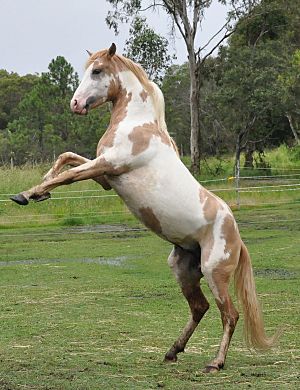Spanish Mustang facts for kids

Spanish Mustang mare
|
|
| Country of origin | Developed in the Americas from foundation bloodstock tracing to Spain |
|---|---|
| Traits | |
| Distinguishing features | Compact, sturdy, Spanish type |
The Spanish Mustang is a special American horse breed. These horses are descendants of horses first brought from Spain to the Americas a long time ago. They are part of a bigger group called the Colonial Spanish horse. This type of horse is now very rare in Spain.
By the early 1900s, many wild mustangs, which came from these Spanish horses, had almost disappeared. Some horse lovers saw that these horses were in danger of vanishing forever. So, they started working hard to find and save the remaining "Spanish Mustangs." They found horses from wild herds, Native American herds, and ranches. These horses looked like their Spanish ancestors. The Spanish Mustang was one of the first breeds to be saved in this way. A special group, called a breed registry, was started in 1957 to keep track of them.
The Spanish Mustang you see today is a domesticated breed. This means they are raised by people. They are different from the wild free-roaming mustangs you might hear about. Wild mustangs come from both Spanish horses and other horses that escaped. Many wild mustangs live in special areas in the western United States. These areas are managed by the Bureau of Land Management (BLM). Some wild herds also live in Canada. DNA studies show that some wild mustang herds still have Spanish horse genes. These include herds in places like Arizona, Montana, Utah, and Oregon.
Contents
History of the Spanish Mustang
The Colonial Spanish horse came from horses first brought from the Iberian Peninsula (Spain and Portugal). This happened when Spain was taking over and setting up colonies in what is now Mexico. As the Spanish moved through Mexico in the 1500s, their horse herds grew. These horses then spread north and crossed the Rio Grande river.
Over the next 100 years, Native American tribes like the Apache, Comanche, Utes, and Shoshone traded and took these horses. The horses then spread across the Great Plains and Rocky Mountains.
In the early 1900s, the Spanish Mustang was almost gone. But then, a planned effort began to save these horses. Robert E. Brislawn and his brother Ferdinand L. Brislawn led this effort. Gilbert Jones and Ilo Belsky also helped a lot. They gathered horses from wild mustang herds, Native American herds, and ranches. They chose horses that looked like they had Spanish ancestors.
Two brothers, Buckshot and Ute, were very important early stallions. Their father, Monty, was a buckskin stallion caught in Utah in 1927. Monty escaped back into the wild in 1944 and was never caught again. The Brislawns and Lawrence P. Richards created the Spanish Mustang Registry in 1957. Later, some people had different ideas about which horses to include. So, Gilbert Jones started the Southwest Spanish Mustang Association in 1977. Other groups also formed later. A study in 2006 found that Spanish Mustangs have DNA that shows they came from horses of the Iberian Peninsula.
What Spanish Mustangs Look Like
Spanish Mustangs are usually between 13.2 to 15 hands (54 to 60 inches, 137 to 152 cm) tall. Horses taller than 15 hands are not preferred. They weigh about 650 and 1,100 pounds (290 and 500 kg). They have smooth muscles, short backs, and rounded rumps. Their tails are set low. They are well-balanced and have a strong, "uphill" build. This means their front end is a bit higher than their back.
They have deep chests and shoulders that slope back nicely. Their faces are straight or slightly curved inward. They have wide foreheads. Male horses (stallions) have strong, arched necks. Their chests are not too wide but are well-defined. Small bumps called chestnuts are often small or missing, especially on their back legs. Small bumps called ergots are also small or not there. Their feet are round and hard. Their legs are strong and straight, though their back legs might be set a little under them. Their lower leg bones (cannons) are short and rounded.
Some Spanish Mustangs can do a special walking style called an amble. This is a smooth, four-beat gait. Their legs should move straight. If their legs swing out a little, it's usually okay as long as it doesn't cause problems.
Colors of Spanish Mustangs
Spanish Mustangs come in many different colors. This is because their Spanish ancestors had a wide range of colors. You will often see them in bay (brown body, black mane/tail), chestnut (all reddish-brown), black, and gray.
Other colors you might see include Appaloosa patterns (spots) and paint patterns (large patches of white and another color). They can also be solid colors like grulla (mouse-gray), buckskin (tan body, black mane/tail), palomino (golden body, white mane/tail), cremello (cream-colored), isabella (pale yellow), roan (mixed white and colored hairs), and perlino (pale cream).
What They Are Good At
Spanish Mustangs are known for being very tough and having lots of stamina. This means they can go for a long time without getting tired. Because of this, some people use them for endurance riding, which is a sport where horses travel long distances. Spanish Mustangs also compete in many other riding events. These include both English riding and Western riding styles.
See also
 In Spanish: Mustang español para niños
In Spanish: Mustang español para niños


